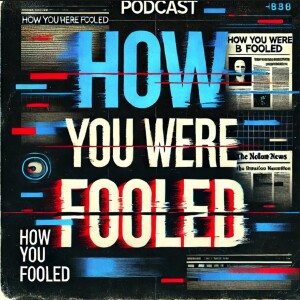Episodes

5 days ago
5 days ago
This episode explores the famous belief that eating carrots improves eyesight — a “fact” most people learned in childhood. While carrots are rich in beta-carotene, which the body converts into vitamin A (an essential nutrient for maintaining normal vision), eating extra carrots does not give anyone superhuman sight. Once your body has enough vitamin A, additional amounts don’t make your vision any sharper.
The origin of this myth dates back to World War II, when the British Royal Air Force wanted to keep its new radar technology secret. To disguise the real reason their pilots could spot enemy planes at night, the government spread a cover story claiming that British pilots had exceptional night vision because they ate lots of carrots. The propaganda worked so well that it became accepted as scientific truth.
Over time, the myth spread globally through schools, advertisements, and everyday advice. It persisted because it was simple, harmless, and believable — combining real nutrition facts with an appealing message of self-improvement.
The truth? Carrots support normal eye health, but they don’t enhance it beyond natural limits. The idea that they improve night vision was clever wartime misinformation — proof that even a well-meaning lie can last for generations.

Friday Oct 24, 2025
Friday Oct 24, 2025
This episode uncovers the truth behind the long-standing myth that bulls become enraged when they see the color red. Contrary to popular belief, bulls are color-blind to red and green — they are dichromatic animals that can only perceive shades of blue and yellow. The real trigger for a bull’s charge in a bullfight is movement, not color.
The famous red cape, or muleta, used by matadors isn’t meant to provoke the bull at all — it’s meant for the audience. The color red symbolizes passion and danger while conveniently hiding the blood that appears during the fight. The myth took hold because of centuries of artistic symbolism, storytelling, and repetition. Humans associated the color red with anger, and over time, projected that idea onto the animal.
Scientific experiments have confirmed that bulls charge equally at moving objects of any color — red, blue, yellow, or white. They ignore motionless ones entirely. This proves that motion, not hue, provokes the bull’s aggression.
Ultimately, the story of the “angry bull and the red cape” reveals more about human psychology than animal behavior. We were fooled by symbolism, tradition, and our tendency to see emotions in animals that don’t think the way we do. The red cape, it turns out, was always for us — not for the bull.

Sunday Oct 19, 2025
Sunday Oct 19, 2025
This episode debunks the widespread belief that shaving causes hair to grow back thicker, darker, or faster. The truth is clear: shaving does not change the structure, speed, or color of hair growth. It only appears thicker because shaving cuts the hair straight across, leaving a blunt, flat tip instead of its natural soft, tapered end. That blunt regrowth feels rougher and looks darker — creating an illusion of thicker hair.
The myth spread due to visual misinterpretation, old flawed studies, and generations of repeated advice, not science. In reality, hormones and genetics — not razors — control hair growth. If shaving truly made hair stronger, bald men would shave to cure hair loss, which clearly doesn’t work.
The takeaway: Your razor isn’t rewriting your DNA. Shaving doesn’t make hair thicker — it just changes how it looks and feels temporarily.

Saturday Oct 11, 2025
Saturday Oct 11, 2025
This episode debunks the common belief that humans have only five senses — sight, hearing, smell, taste, and touch. While this idea is widely taught in childhood, it actually comes from Aristotle, not modern science. He guessed based on observation, and his framework became tradition rather than scientific fact.

Monday Oct 06, 2025
Monday Oct 06, 2025
This episode examines the enduring myth that medieval doctors used leeches for everything, portraying them as ignorant and superstitious. In reality, leeches were part of a wider medical practice called bloodletting, rooted in the ancient theory of balancing the body’s four humors. While leeches were common, they weren’t a universal cure — medieval physicians also prescribed herbs, diet, baths, rest, and even surgeries.
The image of leeches stuck because it was memorable, dramatic, and symbolic of “backward” medicine, reinforced by satire, art, and the narrative of modern progress. By the 19th century, bloodletting was mocked as barbaric, and the leech became a shorthand for medical ignorance.
However, the twist is that leeches aren’t entirely useless. Modern medicine still uses them in microsurgery and reconstructive procedures, since their saliva contains hirudin, a powerful anticoagulant that helps restore blood flow.
The episode highlights how the myth oversimplifies the past. Medieval medicine was flawed but not completely foolish, and even its strangest practices sometimes contained a kernel of truth. The persistence of the leech image says more about how we like to imagine history than about what actually happened.

Monday Sep 29, 2025
Monday Sep 29, 2025
This episode challenges the well-known saying that “lightning never strikes the same place twice.” While it’s often used as a metaphor for rare events, science shows the opposite is true.
Lightning seeks out the tallest, most conductive objects, and those spots are often hit repeatedly. Famous landmarks like the Empire State Building (struck 20–25 times a year) and the CN Tower (struck over 70 times annually) prove the myth wrong. Even mountains and tall trees experience repeated strikes over time.
The phrase originated in the 19th century as a poetic metaphor and stuck because it was catchy and memorable, not factual. However, believing it literally can be dangerous, as people may think a tree or building already struck is “safe.” In reality, the same location can be hit again within the same storm.
The takeaway? Lightning absolutely strikes the same place twice—and often more. The myth survives because of language and storytelling, but the science is clear: electricity follows the easiest path, even if that path has already been used.

Monday Sep 22, 2025
Monday Sep 22, 2025
This episode explores the famous legend of Isaac Newton’s “apple moment.” While the story of an apple hitting Newton on the head is widely told, it isn’t true. Newton did recall that watching an apple fall made him reflect on why objects always fall straight down, but the dramatic “bonk on the head” version was invented later to make the tale more entertaining.
The myth stuck because it’s a simple, vivid story that makes a complex discovery easy to grasp. In reality, Newton’s theory of gravity came from years of study in mathematics and astronomy, building on the work of thinkers like Galileo and Kepler. The apple wasn’t the cause of his genius, but rather a symbol of his ability to connect ordinary experiences with profound scientific questions.
The episode highlights how we were fooled by a good story—one that humanized Newton, simplified his achievement, and made science more accessible. The truth, though less dramatic, is even more impressive: Newton revolutionized our understanding of the universe not through a single accident, but through relentless study and insight.

Monday Sep 15, 2025
Monday Sep 15, 2025
This episode debunks the myth that people in the Middle Ages believed the Earth was flat. In reality, knowledge of a spherical Earth dates back to ancient Greece, with philosophers like Aristotle and Eratosthenes providing early evidence and calculations. Medieval scholars preserved and expanded on this knowledge, and by Columbus’s time, educated Europeans already accepted Earth’s roundness.
The “flat Earth Middle Ages” myth was actually invented in the 19th century. Writers like Washington Irving dramatized Columbus’s story, portraying him as a hero who defied flat-Earth believers. This narrative served as a way to contrast “ignorant” medieval superstition with “modern” enlightenment, and it stuck in popular imagination.
In truth, the real debate in 1492 was not about the Earth’s shape but about its size and whether ships could cross the ocean with available supplies. Columbus’s critics weren’t flat-Earth believers — they were concerned realists.
The episode highlights how a powerful storytelling device can overshadow facts, showing that myths endure not because they’re true but because they’re memorable. The flat Earth story says more about the 19th century than it does about the Middle Ages.

Saturday Sep 06, 2025
Saturday Sep 06, 2025
This episode debunks the disturbing myth that humans swallow eight spiders a year while asleep. The claim didn’t come from scientific research but from a 1990s article that used it as an example of how easily misinformation spreads. Ironically, the “example” itself became one of the internet’s most repeated fake facts.
Science makes it clear: spiders avoid humans, are scared by movement and vibrations, and find our mouths unattractive environments. The odds of one crawling inside while we sleep are close to zero. In reality, the number of spiders we swallow in our lifetimes is most likely none at all.
The myth stuck because it’s shocking, disgusting, and memorable — and because repetition made it feel true. Psychologists call this the illusory truth effect. Media, horror stories, and pop culture reinforced it further.
Ultimately, the episode shows how a creepy but catchy idea became accepted as “fact,” proving just how easily we can be fooled when fear and curiosity overpower evidence. The truth? You can sleep peacefully — no spiders are sneaking in.

Friday Aug 29, 2025
Friday Aug 29, 2025
This episode debunks the long-standing myth that swimming right after eating causes cramps and can lead to drowning. The belief likely originated in the early 20th century as a way for parents and instructors to keep kids safe, reinforced by the “wait 30 minutes before swimming” rule.
In reality, while digestion does increase blood flow to the stomach, it does not deprive the muscles of oxygen. Scientific studies, along with statements from organizations like the American Red Cross and Johns Hopkins, show that eating before swimming poses no danger of drowning. At worst, someone might feel a little sluggish or uncomfortable if they swim vigorously on a full stomach.
The myth persists because it sounds logical, it was repeated for generations, and it provided a simple way to enforce caution. The real risks in swimming come from alcohol use, fatigue, or lack of supervision, not from having a meal beforehand.
In short, you can safely swim after eating — the myth is nothing more than a well-intentioned but scientifically unfounded warning.





